Daily ridership 817,793 Owner New York City Stations 22 | System New York City Subway Number of tracks 2–5 Character Rapid transit | |
 | ||
Opened 1915–1928 (between Times Square and Flushing–Main Street)September 13, 2015 (between 34th Street and Times Square) Track gauge 4 ft 8 ⁄2 in (1,435 mm) Terminis 34th Street–Hudson Yards, Flushing–Main Street | ||
Nyc subway irt flushing line on a sunny saturday
The IRT Flushing Line is a rapid transit route of the New York City Subway system, operated as part of the A Division. Originally an Interborough Rapid Transit Company-operated route, the Flushing Line, as originally built, ran from Flushing, Queens, to Times Square, Manhattan; a western extension was built to Hudson Yards in western Manhattan, and the line now stretches from Flushing to Chelsea, Manhattan. It carries trains of the 7 local service, as well as the express <7> during rush hours in the peak direction.
Contents
- Nyc subway irt flushing line on a sunny saturday
- Nyc subway rush hour action on the irt flushing line
- Route
- Distinctions
- Origins
- Construction under the Dual Contracts
- Service curtailments and slight improvements
- Decline and rehabilitation
- Automation of the line
- Extension westward
- References
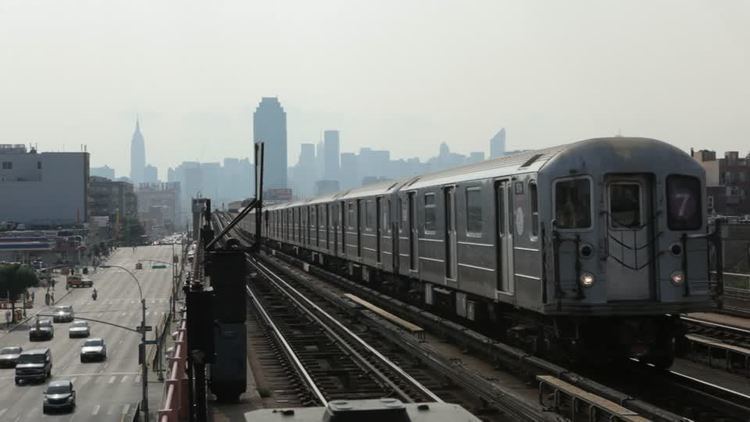
It is shown in the color raspberry on station signs, the official subway map, internal route maps in R188 cars, and route signs on the front and sides of R62A subway cars. Before the line was opened all the way to Flushing, it was known as the Corona Line or Woodside and Corona Line. Prior to the discontinuance of BMT services in 1949, the portion of the IRT Flushing Line between Times Square and Queensboro Plaza was known as the Queensboro Line.
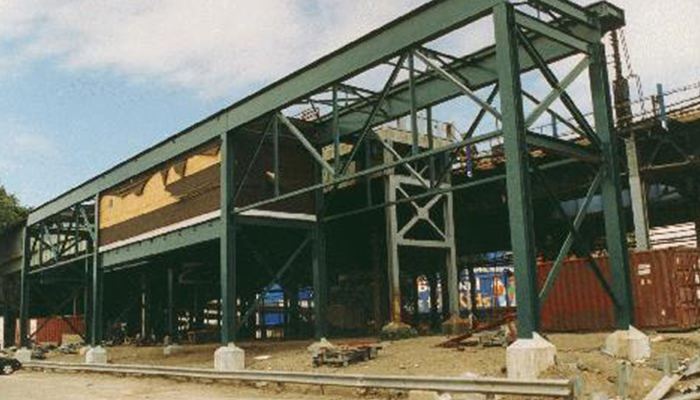
The Flushing Line has various styles of architecture, which range from steel girder elevated structures to European-style concrete viaducts. The underground stations have some unique designs as well. The designs include Hunters Point Avenue, which is in an Italianate style; Grand Central–42nd Street, which is a single round tube similar to a London Underground station; and 34th Street–Hudson Yards, which, with its deep vault and spacious interior, resembles a Washington Metro station.

Nyc subway rush hour action on the irt flushing line
Route
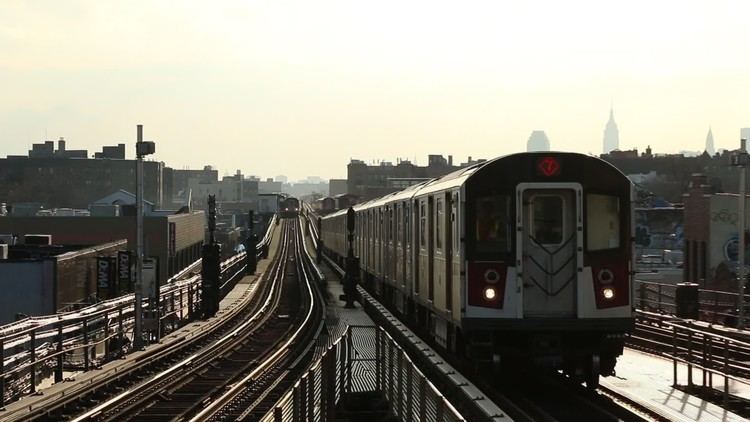
Services that use the Flushing Line are colored raspberry. The following services use part or all of the Flushing Line:
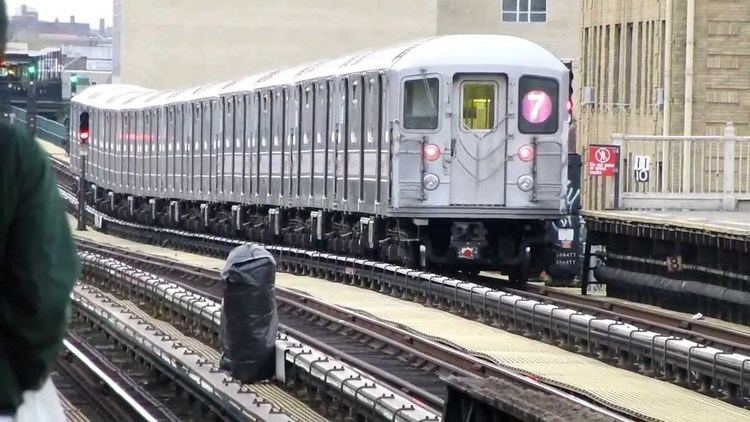
The line has two distinct sections, split by the Queensboro Plaza station. It begins as a three-track subway, with the center track used for express service, at Flushing–Main Street. It quickly leaves the ground onto a steel elevated structure above Roosevelt Avenue, passing Citi Field and the United States Tennis Association's National Tennis Center. A flying junction between Mets–Willets Point and 111th Street provides access to the Corona Yard from the local tracks. At 48th Street in Sunnyside, the line switches to Queens Boulevard and an ornate concrete viaduct begins. The express track ends between 33rd Street–Rawson Street and Queensboro Plaza.
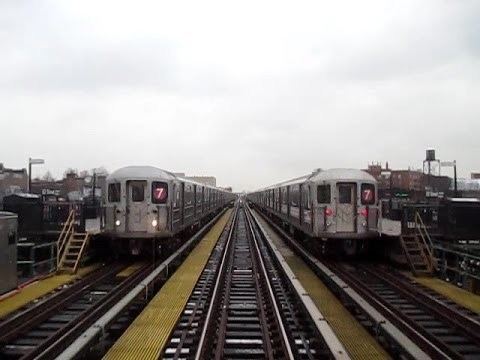
At Queensboro Plaza, the eastbound track (railroad north) is above the westbound track, with both tracks on the south side of the island platforms. On the north side of these platforms is the BMT Astoria Line. East of this point, both the Flushing Line and the Astoria Line were formerly operated by the IRT and the BMT, respectively; details on that dual operation are in the Background section. Connections still exist between the eastbound tracks just east of the platforms, but they cannot be used for revenue service because BMT trains are wider than IRT trains. This is the only track connection between the Flushing Line and the rest of the subway system.
West of Queensboro Plaza, the line immediately turns south onto an elevated structure over 23rd Street. It heads into the west end of Amtrak's Sunnyside Yard, and passes through two underground stations before entering Manhattan via the Steinway Tunnel under the East River. In Manhattan, the line runs under 42nd Street, with part directly underneath the 42nd Street Shuttle (S train), before angling towards 41st Street. The Times Square–42nd Street station, with no track connections to other lines, is directly under 41st Street.
Just west of Times Square, the tracks curve sharply downward before turning under 11th Avenue. The tracks end at 24th Street, although the last station is at 34th Street. This segment was built as part of the extension of the Flushing Line west to Manhattan's Far West Side (see below). A decommissioned lower level at the IND Eighth Avenue Line's 42nd Street–Port Authority Bus Terminal station formerly blocked the way; it had been rumored that the IND built it to keep the IRT from extending the Flushing Line, although no blueprints indicate that the IRT planned such an expansion. While some originally questioned the necessity of the plan, with London receiving the 2012 Summer Olympics, the city pursued it as a means to enable the redevelopment of the far West Side under the Hudson Yards Redevelopment Project.
Distinctions
The Flushing Line is one of only two New York City non-shuttle subway lines that hosts only a single service and does not share operating trackage with any other line or service; the other is the BMT Canarsie Line, carrying the L service. Because of this, the MTA is automating the line with new trains using communication-based train control (CBTC), similar to the Canarsie Line.
The IRT Flushing Line's 7 service has the distinction of running trains with the largest number of cars in the New York City Subway. 7 trains are eleven cars long; most other New York City Subway services run ten or eight-car trains. The trains are not the longest by total length, however. An IND/BMT train of ten 60-foot (18 m)-long cars or eight 75-foot (23 m)-long cars, which is 600 feet (180 m) long, is still 35 feet (11 m) longer than an IRT train of eleven 51.4-foot (15.7 m)-long cars, which is 565 feet (172 m) long.
Origins
The earliest origins of the Flushing Line emerged on February 25, 1885, with the construction of the East River Tunnel Railroad in the Steinway Tunnel and an objective to connect the Long Island Rail Road with the New York Central Railroad. Although the East River Tunnel Railroad's builders considered the plan, no action was taken, and the railroad was redesignated as the New York and Long Island Railroad Company in 1887. To run from West 42nd Street and Tenth Avenue to Van Alst Avenue after crossing under the East River, the builders planned for the remainder of the line to be constructed on private lands, and numerous alterations were made to the proposal. In 1890, William Steinway advised the company to utilize electricity to power the tunnels, believing that the construction of the tunnel would increase the value of his properties in the vicinity.
On June 3, 1892, building of the tunnel commenced near the intersection of 50th Avenue and Vernon and Jackson Avenues. However, several failures and hindrances, which included an underground spring preventing the extraction of rubble, resulted in the termination of the project on February 2, 1893. Several calls for the resumption of the project between 1893 and 1896, in addition to a proposed extension to New Jersey, were futile. The tunnel opened for subway use on June 22, 1915, with service running between Grand Central and Vernon–Jackson Avenues.
The Flushing Line was extended one stop from Vernon–Jackson Avenues to Hunters Point Avenue on February 15, 1916. On November 5, 1916, the Flushing Line was extended two more stops to the east to the Queensboro Plaza station.
Construction under the Dual Contracts
At Queensboro Plaza, the line met the BMT's 60th Street Tunnel, as well as a spur from the elevated IRT Second Avenue Line on the Queensboro Bridge. From this point east, the Flushing and Astoria Lines were built by the City of New York as part of the Dual Contracts. They were officially IRT lines on which the BMT held irrevocable and equal trackage rights. Because BMT trains were wider, and the platforms had been built for the IRT, normal BMT trains ran only to Queensboro Plaza, with a transfer to shuttles, using elevated cars, that alternated between the Astoria–Ditmars Boulevard and Flushing–Main Street terminals. IRT trains simply continued from the Queensboro Line and Queensboro Bridge onto the lines to Astoria and Flushing, which was originally called the Corona Line or Woodside and Corona Line before it was completed to Flushing.
The line was opened from Queensboro Plaza to Alburtis Avenue on April 21, 1917. BMT shuttles began to use the Flushing and Astoria Lines on April 8, 1923. East of there, sources conflict on when each section opened. A New York Times article from May 8 reports that service began on May 7 to what is now the Mets–Willets Point station, and mentions delays due to the structure sinking. Articles from May 13 and 15 cover a celebration to coincide with the opening to the Willets Point stop on May 14. Finally, a January 22, 1928 article reports that the line had ended at 103rd Street–Corona Plaza until January 21; the extension had been finished over a year earlier but had to be strengthened due to structural problems.
The eastern extension to Flushing–Main Street opened on January 2, 1928. However, Flushing–Main Street was not originally intended to be the end of the line. The Public Service Commission, in June 1913, was actively engaged in considering extensions of the line beyond Flushing, but these extensions, later planned by the city as part of a large system expansion, were never built. At the time, the line continued past Flushing–Main Street and into a train storage area.
On March 22, 1926 the line was extended one stop westward from Grand Central to Fifth Avenue. The line was finally extended to Times Square on March 14, 1927.
For the 1939 New York World's Fair, the Willets Point Boulevard station was rebuilt and centered on 123rd Street, just west of where the station originally lay. Some remnants of the old station are still visible; ironwork tends to indicate where the older outside-platform stations were, and the remains of the fare entry area can be seen east of the current station. The original Willets Point Boulevard station was a "minor" stop on the Flushing Line; it had only two stairways and short station canopies at platform level. It was rebuilt into the much larger station in use today, and the ramp used during two World's Fairs still exists, but is only used during special events, such as the US Open for tennis. Express service to the World's Fair began on the Flushing Line on April 24, 1939. This was the first time the middle express track had been used for revenue service; prior to the fair, the express track had only been used for non-revenue moves and re-routes during construction.
Currently and historically, the IRT assigned the number 7 to its Flushing Line subway service, though this did not appear on any equipment until the introduction of the R12 class cars in 1948. The BMT assigned the number 9 to its service, used on maps but not signed on trains.
Service curtailments and slight improvements
In 1942, when IRT Second Avenue Line service ended, major overhauls for the Corona fleet were transferred to the Coney Island shop. In addition, free transfers to the IRT Third Avenue Line were offered at Grand Central from June 13, 1942 (when Second Avenue Line service ended, including the Queensboro Bridge connection) until May 12, 1955 (when Third Avenue Line service ended).
In the fall of 1949, the joint BMT/IRT service arrangement ended. The Flushing Line became the responsibility of IRT. The Astoria Line had its platforms shaved back, and became BMT-only. Because of this, routes through the then eight-track Queensboro Plaza station were consolidated and the northern half of the structure was later torn down. Evidence of where the torn-down platforms were, as well as the trackways that approached this area, can still be seen in the ironwork at the station.
The station's extra-long platforms, which allow for 11-car operation, are also a remnant of the joint service period. However, the rest of the stations on the line were only able to fit 9-car train sets. These platforms were extended to 11 cars in the late 1950s as the signal system was being improved on the Flushing Line.
Identification of Trains and Routing Automatically (IDENTRA) was implemented on the line in the 1957 and used until 1997, when a route selector punch box with B1 Astoria, local/express buttons was installed at the 10/11 car marker on the upper level of Queensboro Plaza. IDENTRA used a removable round circular disc type radio antenna assembly, slide-mounted on the small mounting brackets that were attached on the front of R12, R14, R15, and R17 cars that were assigned to the 7 route, which had been used on the line since 1948. Similar to the use of radio transponders in the CBTC installation, the system used the antennas to determine whether a train was running local or express, and then accordingly switched the track at interlockings near the Queensboro Plaza and Flushing–Main Street stations. This move reduced the number of signal towers on the line from 9 to 2 and allowed to operate 37 eleven-car trains instead of only 30 nine-car trains per hour. The consolidated signal system was in use by 1956 while the selector system was in service by 1958. This system, still in use by many transit agencies such as SEPTA's Broad Street Line, is also nicknamed the "toilet seat" because the removable disc antenna is shaped like a toilet seat.
In 1954, with increased ridership on the line, the trains were lengthened to nine cars each, and were extended to ten cars on November 1, 1962. With the 1964–1964 World's Fair in Flushing Meadows–Corona Park in April 1964, trains were lengthened to eleven cars from ten cars.
Rolling stock along the Flushing Line received "strip maps" in 1965, the first such installation in the system. The strip maps showed Flushing Line stations only, but the transfers available at each station were listed.
Decline and rehabilitation
As with much of the rest of the subway system, the IRT Flushing Line was allowed to deteriorate throughout the 1970s to the late 1980s. Structural defects that required immediate attention at the time were labeled as "Code Red" defects or "Red Tag" areas, and were numerous on the Flushing Line. Some columns that supported elevated structures on the Flushing Line were so shaky that trains did not run when the wind speed exceeded 65 miles per hour (105 km/h). This was particularly widespread on the Flushing and the BMT Jamaica Lines.
On May 13, 1985, a 4 1⁄2-year long project to overhaul the IRT Flushing Line commenced. It forced single-tracking on much of the line during weekends, and the elimination of express service for the duration of the project. The MTA advertised this change by putting leaflets in the New York Times, the Staten Island Advance, the Daily News, and Newsday. The project laid new track, replaced or repaired concrete and steel structures, replaced wooden station canopies with aluminum, improved lighting, improved signage, and installed new ventilation and pumping equipment. Expanded service was provided when the Mets played home games or when there were sporting events in Flushing Meadows–Corona Park. Paradoxically, Flushing local trains had better on-time performance during the construction than before it started.
The $60 million rehabilitation project on the Queens Boulevard concrete viaduct ended on August 21, 1989. When Flushing express service was restored, trains no longer stopped at 61st Street–Woodside. This led to protests by community members to get express service back at 61st Street station. The reason for the discontinuance on the Flushing express was because the MTA felt it took too long to transfer between locals and expresses. The service was also due to fears of delays on the line when locals and expresses merged after 33rd Street–Rawson Street. The change was supposed to enable local trains to stop at 61st Street every four minutes (15 trains per hour) during rush hours, but according to riders, the trains arrived every 8–10 minutes. The community opposition led to service changes, and expresses began stopping at Woodside again a few months later.
Automation of the line
In January 2012, the MTA selected Thales for a $343 million contract to set up a communications-based train control (CBTC) system as part of the plan to automate the line. This was the second installation of CBTC, following a successful implementation on the BMT Canarsie Line. The total cost was $550 million for the signals and other trackside infrastructure, and $613.7 million for CBTC-compliant rolling stock. The safety assessment at system level was performed using the formal method Event-B.
The MTA chose the Flushing Line for the next implementation of CBTC because it is also a self-contained line with no direct connections to other subway lines currently in use. Funding was allocated in the 2010–2014 capital budget for CBTC installation on the Flushing Line, with scheduled installation completion in 2016 or 2017. The R188 cars were ordered to equip the line with compatible rolling stock. CBTC on the line will allow the 7 <7> services to run 2 more trains per hour (tph) during peak hours (it currently runs 27 tph). However, the system is currently retrofitted to operate at 33 tph even without CBTC.
The first train of R188 cars began operating in passenger service on November 9, 2013. Test runs of R188s in automated mode were set to start in late 2014.
Completely independent of the CBTC installation is the 7 Subway Extension (see below), which features both CBTC signals and fixed-block signaling. The extension will also increase line capacity.
Extension westward
The IRT Flushing Line was extended westward and southward in Manhattan, and the extension opened September 13, 2015. There is only one new station at 34th Street and Eleventh Avenue to serve Hudson Yards; in the MTA's original plans, there was another station proposed at 10th Avenue and 41st Street. Funding was in place and construction began in late 2007. The extension's opening was delayed several times.
